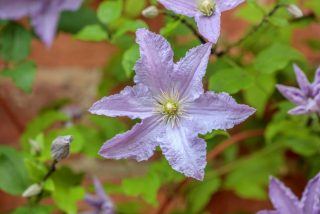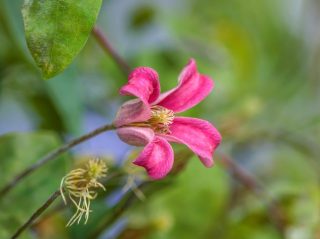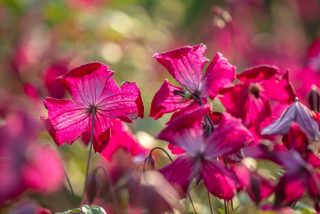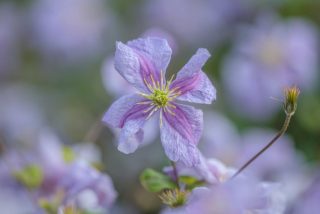Tireless Clematis
As August begins, we can start to enjoy the long, warm summer days when the garden is full of flower scent and buzzing with life. The roses fade from their first spectacular show and take a well-earned rest, before reflowering later in the summer and in their place, Clematis become the stars of the show. These tireless stalwarts are firm favourites in the garden and at Morton Hall we grow over 80 different cultivars.
Clematis is a large and diverse genus of over 200 species of mostly climbing perennials with varied flower shapes and pruning requirements. With more than 400 varieties in cultivation, they are a group of plants highly valued for their riot of summer colour, but they can often seem daunting to care for.
Clematis can be categorised into 3 main groups. At Morton Hall it is
mainly the group 3 Clematis that are in full flower in our borders in
August and here are four of our favourites.

Clematis ‘Prince Charles’ is a late large-flowered Clematis flowering
from early summer to early autumn. It looks equally at home on the red
brick wall of the Coach house, with the white-flowered climbing rose,
Rosa ‘Clarence House’, or on one of our hazel supports with the
white-flowered shrub rose, R. ‘Winchester Cathedral’. This is a clematis
that produces a profusion of large, star-shaped, gently nodding,
violet-blue flowers with a greenish-yellow centre that flower singularly
on the current season’s growth.

Texensis Group Clematis also flower on the current season’s growth
but produce smaller, tulip-shaped flowers slightly later in the year
from mid-summer into early autumn. C. ‘Princess Diana’ is one of these
and another of member of our royal family Clematis! Luminous single
pink-red, tulip-shaped flowers cover the plant as it scrambles up the
trunks of the silver pears in the South Garden.

Viticella Group Clematis are categorised as group 3 Clematis as they
also flower on the current season’s growth and we use many of these on
our homemade hazel supports in the borders, either freestanding or
growing alongside companion roses. C. ‘Kermesina’ is one of our
favourites and is used throughout the garden alongside creamy-white and
pink roses in the South Garden. It produces deep crimson flowers from
midsummer through to early autumn with each single flower having a white
base to the petals and a dark centre.

Last but not least is another Viticella Group Clematis, C. ‘Chatsworth’. Growing in the West Garden, it produces pale lilac-blue flowers with darker stripes on each petal and a pale greenish-yellow centre, flowering from midsummer through to early autumn.
All these Clematis are extremely vigorous and free-flowering plants being very popular with bees who are attracted to their pollen and sometimes provide nectar, making them a splendid addition to the mid to late summer border.
